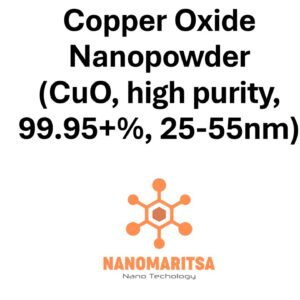Hafnium Oxide Nanopowder (HfO2, 99.99%,high purity, 61-80nm)
€864.00
CompareHafnium oxide nanopowder (HfO₂, 99.99%, high purity, 61–80 nm) is a specialized material with outstanding thermal, electrical, and mechanical properties. Its high purity and specific particle size range make it valuable in advanced technological applications, including semiconductors, optics, and energy storage. Due to its exceptional stability and versatility, it is a key material in industries requiring high-performance ceramics and thin films.
Composition and Structure
HfO₂ (Hafnium Oxide):
Hafnium oxide is a compound of hafnium and oxygen. It is a refractory material known for its high melting point and excellent insulating properties. Hafnium oxide exhibits several phases, including monoclinic, tetragonal, and cubic, depending on temperature and pressure conditions, and can be engineered for various applications.
Purity (99.99%):
The extremely high purity of this nanopowder (99.99%) ensures minimal contaminants, making it ideal for precision applications such as semiconductor manufacturing, where impurity levels must be tightly controlled.
Particle Size (61–80 nm):
The nanopowder’s particle size in the range of 61 to 80 nm offers a balance between surface area and stability. This size range is ideal for enhancing the material’s reactivity and surface properties while maintaining its mechanical integrity.
Properties
- High Thermal Stability:
Hafnium oxide has an extremely high melting point (around 2,800°C), making it suitable for applications requiring materials that can withstand extreme temperatures without degrading. - Electrical Insulation:
HfO₂ is an excellent electrical insulator, with a wide bandgap, making it useful in semiconductor devices and high-voltage applications. - High Dielectric Constant:
The material exhibits a high dielectric constant, which makes it useful in capacitor applications and in enhancing the performance of integrated circuits. - Mechanical Strength:
Hafnium oxide nanoparticles have strong mechanical properties, including high hardness and resistance to wear, making them valuable in applications where durability is required. - Optical Transparency:
At certain wavelengths, HfO₂ is transparent, which is beneficial in optical coatings and photonic applications.
Applications
1. Semiconductors and Electronics:
Gate Dielectrics in MOSFETs:
Hafnium oxide is widely used as a high-k dielectric material in semiconductor manufacturing, especially in MOSFET (metal-oxide-semiconductor field-effect transistor) devices, where it improves device performance by reducing leakage currents.
Capacitors and Integrated Circuits:
Its high dielectric constant makes HfO₂ suitable for use in capacitors and various components in integrated circuits, contributing to improved energy storage and efficiency.
Memory Devices:
HfO₂ is also being explored for use in resistive random-access memory (ReRAM) and other non-volatile memory devices due to its excellent insulating properties and scalability.
2. Optics and Photonics:
Optical Coatings:
Hafnium oxide is used in optical coatings, such as anti-reflective coatings, mirrors, and lenses, where its optical properties, including transparency and high refractive index, are advantageous.
Laser Systems:
Due to its high melting point and optical properties, HfO₂ is employed in high-power laser systems and optical fibers.
Photonic Devices:
Hafnium oxide is utilized in photonic devices and waveguides for applications that require precise light manipulation and high thermal stability.
3. Energy Storage and Catalysis:
Solid-State Electrolytes:
Hafnium oxide is being explored for use as a solid-state electrolyte in advanced battery technologies, especially in high-energy-density applications.
Catalysts:
HfO₂ nanoparticles can serve as catalysts or catalyst supports in various chemical reactions, particularly in the petroleum and chemical industries, where their high surface area and thermal stability enhance catalytic performance.
4. Aerospace and Defense:
Thermal Barrier Coatings:
Due to its excellent thermal stability, HfO₂ is used in thermal barrier coatings in aerospace applications, particularly in turbine engines, where the material helps protect components from extreme heat.
Nuclear Applications:
HfO₂’s ability to absorb neutrons makes it useful in nuclear reactors, where it can be used as a radiation shield or in the development of nuclear fuel components.
5. Research and Development:
Nanotechnology:
Hafnium oxide nanoparticles are widely used in research to develop new nanomaterials and thin films for various technological advancements. Their unique properties make them valuable for studying high-performance materials, catalysis, and nanostructures.
Quantum Computing:
HfO₂ is also being explored for use in quantum computing technologies, particularly in the development of quantum bits (qubits) and the stabilization of quantum states due to its high stability and insulative properties.
Safety and Handling
Health Considerations:
Hafnium oxide is considered to be relatively low in toxicity, but like all nanoparticles, it should be handled with care. Proper protective equipment, including gloves, masks, and eyewear, should be used to avoid inhalation or skin contact.
Environmental Impact:
Hafnium oxide is chemically stable and does not pose significant environmental risks under normal conditions. However, as with all nanomaterials, proper disposal and environmental safety measures should be observed.
Summary
Hafnium oxide nanopowder (HfO₂, 99.99%, high purity, 61–80 nm) is a high-performance material with exceptional thermal, electrical, and mechanical properties. It is widely used in semiconductors, optics, energy storage, and aerospace industries. The material’s high purity and tailored particle size make it suitable for a wide range of advanced applications, including high-k dielectrics in transistors, optical coatings, catalysts, and energy devices. As research in nanotechnology continues, hafnium oxide nanopowder is poised to play an increasingly important role in next-generation technologies.
| Measurement (gr) | 100 grams, 500 grams, 1000 grams |
|---|






